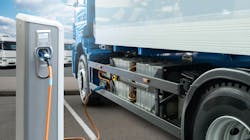Duke Energy Pairs Microgrid and the Grid for More Reliable EV Charging
For the second time this month, utility giant Duke Energy has put forward a microgrid project meant to break new ground in the technology’s use.
The most recent project is the creation of a depot near its Mount Holly, North Carolina, microgrid to demonstrate how to charge electric vehicle (EV) fleets from both a microgrid and the grid.
Earlier this month, the utility powered an entire town — Hot Springs, North Carolina — with a microgrid.
The Mount Holly project is designed to help speed the electrification of commercial fleets, a growth market for both utilities and microgrids. Some fleet owners are turning to microgrids out of concern about grid reliability or because they want to manage costs or emissions with on-site energy resources.
Duke wants to create a model for reliable charging with a depot that allows for commercial-grade charging from either Duke’s grid or the all-renewable microgrid. On-site resources will include solar, energy storage, and microgrid controls and optimization software.
“Electric fleet commitments are increasing as companies with ambitious sustainability goals work to decarbonize business operations,” said Harry Sideris, executive vice president of customer experience, solutions and services for Duke Energy. “We are helping speed commercial fleet electrification across the Duke Energy footprint through innovations like this, while we electrify our own fleet.”
Duke is working with two partners on the project: Electrada, an electric fuel solutions company based in Cincinnati, Ohio, and Daimler Trucks North America, a heavy duty truck manufacturer based in Portland, Oregon.
Electrada offers a charging-as-a-service , where it installs and operates charging equipment, taking on the capital expense. Fleet owners pay predictable fueling costs over time.
“Reducing long-term energy cost and performance risk creates a smoother transition for fleets, increases confidence in electrification, and enables the technology to become more mainstream,” said Kevin Kushman, CEO of Electrada.
Daimler is joining the effort because one of its East Coast manufacturing facilities is located adjacent to the charging depot. The trucking manufacturer plans to charge vehicles at the site and demonstrate vehicle electrification for its customers visiting the plant.
The project comes as the Biden administration works to hasten electrification of transportation through new funding and tax credits designed to bring electric vehicles to 50% of new car sales by 2030.
Last year’s Inflation Reduction Act makes tax credits available for electric vehicles, charging infrastructure and microgrids. And the 2021 Bipartisan Infrastructure Law offers $7.5 billion for EV charging, $10 billion for clean transportation, and more than $7 billion for EV battery components, critical minerals and materials.
The White House also announced a series of actions last week to push forward on its electrification goals, including new standards to make charging available for all types of electric vehicles and $2.5 billion in grants for publicly accessible charging and alternative fueling infrastructure in communities, including at schools, grocery stores, parks, libraries and apartment buildings.
The drive toward electrification offers a new market for microgrids, and others, in addition to Duke Energy, are demonstrating how EVs and microgrids will work together.
For example, Montgomery County, Maryland, outside of Washington, D.C., has developed a 5.6-MW microgrid with distributed energy, energy storage, and over 2 MW of charging capacity for its Brookville Smart Energy Bus Depot. The microgrid project was designed and built by AlphaStruxure, a joint venture between Schneider Electric and the Carlyle Group.
Interested in microgrids and electric vehicles. Join us for a special session on the topic at the annual Microgrid Knowledge conference, this year titled Microgrid 2023: Lights On! Registration is now open for the May 16-17 event in Anaheim, California.
About the Author
Elisa Wood
Editor-in-Chief
Elisa Wood is the editor and founder of EnergyChangemakers.com. She is co-founder and former editor of Microgrid Knowledge.
